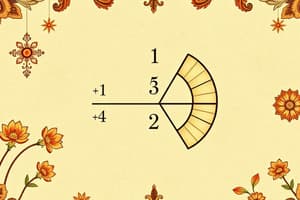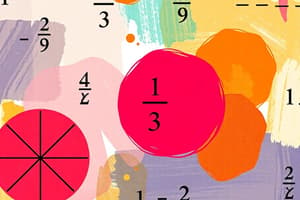Podcast
Questions and Answers
What is the definition of a denominator?
What is the definition of a denominator?
- The number above the line in a fraction
- The number of equal parts in the whole (correct)
- A number with a numerator greater than the denominator
- The part of a fraction below the line (correct)
What is a fraction greater than 1?
What is a fraction greater than 1?
A number which has a numerator greater than the denominator
What are equal parts?
What are equal parts?
Parts that are exactly the same size
What is a fraction?
What is a fraction?
What are halves?
What are halves?
What is a numerator?
What is a numerator?
What are fourths?
What are fourths?
What are eights?
What are eights?
What are sixths?
What are sixths?
What are thirds?
What are thirds?
What is a whole?
What is a whole?
What is a unit fraction?
What is a unit fraction?
Flashcards are hidden until you start studying
Study Notes
Understanding Fractions
- Denominator: Represents how many equal parts are in the whole; appears below the line in a fraction.
- Numerator: Indicates how many parts are being considered; located above the line in a fraction.
Types of Fractions
- Fractions greater than 1: Occur when the numerator exceeds the denominator, indicating a quantity larger than a whole.
- Unit Fraction: A specific type of fraction where the numerator is 1, representing a single part of the whole.
Equal Parts and Their Divisions
- Equal Parts: Parts that are identical in size, crucial for understanding fractions.
- Halves: Result from dividing a whole into 2 equal parts.
- Thirds: Created by splitting a whole into 3 equal segments.
- Fourths: Result from dividing a whole into 4 equal segments.
- Sixths: Arise from dividing a whole into 6 equal parts.
- Eighths: Result from dividing a whole into 8 equal parts.
Concept of Whole
- Whole: Represents the entirety of an object or group before any division into parts.
Studying That Suits You
Use AI to generate personalized quizzes and flashcards to suit your learning preferences.




